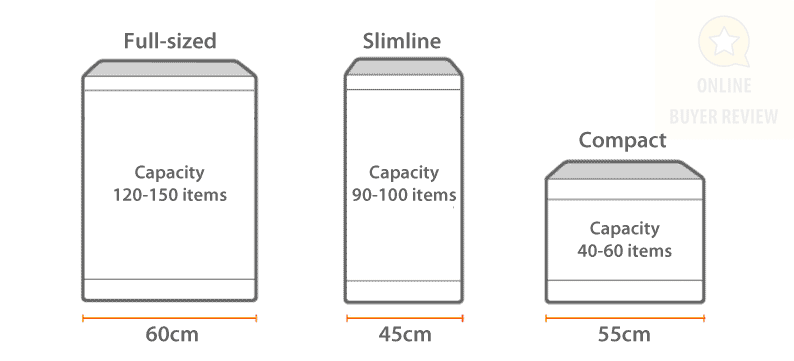Best Dishwasher Buying Guide
A dishwasher can save you up to three weeks a year that you’d otherwise spend chained to the kitchen sink. The best ones use just two bowls of water and less than 10p/cents worth of electricity per wash. Additionally, the best dishwashers effectively remove hard-to-shift foods, such as porridge, egg, and spinach, from dishes and cutlery.
However, that’s not all. It’s important to consider water, electricity consumption, and noise levels. Cheap dishwashers that are awkward and annoying to use should be avoided. This includes assessing the ease of use of the door, controls, loading process, and detergent and rinse aid refilling.
There are several types of dishwashers available online, offering a fairly wide range of features.
Different Sizes of Dishwashers
Standard full-sized dishwashers are typically 60cm wide and can accommodate 12 standard place settings along with serving utensils (equivalent to 75 pieces of crockery and 52 pieces of cutlery). They are ideal for large families or frequent entertainers.
Some manufacturers offer models that can fit up to 15 place settings within the same dimensions as standard dishwashers. However, this may result in crowded crockery and occasionally affect cleaning performance.

For kitchens with limited space, there are two main types of smaller dishwasher models available:
Slimline models, measuring 45cm in width, are approximately one-third narrower than standard dishwashers. They typically accommodate between eight and ten place settings, which is sufficient for smaller households. While they may produce slightly more noise, they generally provide effective cleaning.
Compact or tabletop dishwashers are designed to accommodate four to six-place settings and are comparable in size to a microwave oven. These dishwashers are intended to sit on a work surface or draining board. While only a few brands offer them widely, they are suitable for individuals living alone, holiday homes, or for those seeking to avoid bending down when loading the machine.
Built-in or semi-integrated models
Built-in and semi-integrated dishwashers offer options for seamless integration with your kitchen design. Built-in models feature concealed controls, blending seamlessly with your cabinetry for a cohesive look. These models are ideal for achieving a sleek, modern aesthetic. On the other hand, semi-integrated dishwashers retain a visible control panel, allowing for easier operation and access to settings. This option provides a balance between functionality and aesthetics, offering the convenience of integrated design while still retaining user-friendly controls. Whether you prefer a fully concealed or partially visible control panel, both built-in and semi-integrated models offer versatility and flexibility to suit your kitchen style preferences.
Dishwasher Buying Guide: Program choices
Dishwashers typically offer a variety of program choices to accommodate different cleaning needs and preferences. These programs may include options such as ‘Normal,’ ‘Heavy Duty,’ ‘Quick Wash,’ ‘Eco,’ and ‘Rinse Only.’ Each program is designed to optimize water usage, temperature, and cycle duration based on the level of cleaning required and the type of dishes being washed.
The ‘Normal’ cycle is suitable for everyday use, while the ‘Heavy Duty’ cycle is ideal for heavily soiled dishes. ‘Quick Wash’ offers a shorter cycle for lightly soiled dishes, while ‘Eco’ prioritizes energy efficiency by using less water and electricity. Additionally, the ‘Rinse Only’ program is useful for pre-rinsing dishes before a full wash cycle. With a range of program choices, dishwashers provide flexibility and convenience for efficient dishwashing.
Economy programs
Economy programs in dishwashers aim to conserve water or electricity usage, although some may have longer cycle times. It’s important to note that there is no universal definition of an ‘economy’ program, and their effectiveness can vary between models. While the intent is to promote efficiency, factors such as cycle duration and resource consumption may differ.
For instance, one dishwasher’s standard program might be more economical than another dishwasher’s designated economy program. Therefore, consumers should consider not only the label but also the specific details of each program when selecting a dishwasher. By comparing cycle lengths, resource usage, and overall performance, individuals can make informed choices to meet their needs for both efficiency and effectiveness.
Delicate programs
Delicate programs in dishwashers are designed to protect fragile items such as fine china or glassware from damage during the cleaning process. By using lower temperatures and gentler water pressure, these programs minimize the risk of breakage or chipping while still effectively cleaning delicate items. Additionally, users can further safeguard their china and glassware by ensuring that they are properly spaced apart and do not come into contact with other items during the wash cycle.
This simple precaution helps to prevent potential damage caused by items knocking against each other. By selecting the delicate program and following proper loading techniques, individuals can maintain the integrity of their most fragile dishware while still enjoying the convenience of automated cleaning.
Lower-temperature programs
Lower-temperature programs in dishwashers serve two main purposes: conserving electricity and accommodating delicate items. These programs operate at reduced temperatures compared to standard cycles, thereby reducing energy consumption and lowering utility costs. Additionally, lower temperatures are gentler on fragile items such as fine china or glassware, minimizing the risk of damage during the cleaning process.
By using milder heat settings and shorter cycle times, these programs offer an energy-efficient and safe alternative for washing delicate items. Users can select the lower-temperature program when cleaning heat-sensitive materials or when seeking to minimize energy usage without compromising cleaning performance. With this option, individuals can achieve both environmental sustainability and optimal care for their most delicate dishware.
Half-load programs
Half-load programs in dishwashers offer a convenient option for smaller loads but provide limited water and energy savings compared to full loads. While these programs can save between 10 and 25 percent on water and energy usage, they are notably less efficient than waiting to run a full load. Due to the fixed overhead costs associated with operating the dishwasher, such as heating water and running the motor, the incremental savings from half-load cycles are relatively modest.
As a result, it’s generally more eco-friendly and cost-effective to wait until the dishwasher is fully loaded before running a cycle. By maximizing the capacity of each wash, individuals can minimize resource consumption and optimize the efficiency of their dishwasher usage, ultimately reducing both environmental impact and utility expenses.
Intensive programs
Intensive programs in dishwashers are specifically designed to tackle heavily soiled loads with tough stains and baked-on food residue. By using higher temperatures, increased water pressure, and extended cycle times, these programs provide thorough cleaning performance for the most challenging dishwashing tasks.
Ideal for pots, pans, and dishes with stubborn stains, intensive programs deliver powerful cleaning action to ensure that even the dirtiest items come out sparkling clean. With their robust cleaning capabilities, intensive programs offer peace of mind knowing that your dishes are effectively sanitized and ready for reuse.
Dishwasher Buying Guide: Fuzzy logic
Fuzzy logic technology, employed by brands like Bosch, Siemens, and Whirlpool, introduces a sophisticated approach to dishwashing, akin to its usage in washing machines. With built-in sensors, these dishwashers analyze water condition levels to adapt the cleaning program dynamically. Referred to as ‘automatic’ or ‘auto-program,’ the fuzzy-logic feature optimizes water usage, cycle duration, and temperature based on the detected soil level. By precisely tailoring the cleaning process to the specific needs of each load, fuzzy-logic-enabled dishwashers ensure efficient cleaning while conserving resources.
This innovative technology exemplifies the evolution of dishwashing appliances toward smarter, more intuitive operation for enhanced performance and convenience.
Indicator lights
Indicator lights on dishwashers serve as helpful reminders for maintaining optimal performance and prolonging the lifespan of the appliance. While rinse aid aids in speeding up drying and preventing water marks, dishwasher salt softens hard water, both essential for effective dishwashing. The frequency of their usage varies based on factors like soil level and water hardness. Therefore, having indicator lights to signal when rinse aid or salt levels are low is beneficial. These lights provide timely notifications, ensuring that users replenish supplies as needed, thus avoiding potential damage to the dishwasher and maintaining its efficiency. By heeding these indicators, users can optimize dishwashing results and preserve the condition of their machine.
Child-safety lock
Dishwasher Buying Guide: Child-safety locks are essential features in dishwashers due to the use of potent chemical detergents and high water temperatures during cleaning cycles. Surprisingly, only a limited number of dishwasher models include this safety measure, which prevents the door from being opened while the machine is in operation. Given the potential hazards posed by exposure to hot water and detergents, especially for young children, the absence of a child-safety lock can be concerning.
Implementing this feature ensures added protection against accidents and provides peace of mind for parents or caregivers. Therefore, when selecting a dishwasher, it is advisable to prioritize models equipped with child-safety locks to safeguard against unintended access and promote household safety.
Flexible racks and baskets
Flexible racks and baskets are invaluable features in dishwashers, catering to diverse crockery and glassware needs and varying load configurations. Premium models offer adjustable or removable lower baskets and height-adjustable upper baskets, enabling customization to accommodate larger items like plates or saucepans in the lower basket while sacrificing space in the upper one. Conversely, tall glasses can be accommodated in the top basket, with reduced space below.
Additionally, some models feature tilting upper baskets, facilitating optimal space utilization. These versatile design elements enhance convenience and efficiency, ensuring that users can adapt their dishwasher configurations effortlessly to suit their specific load requirements and maximize usable space for thorough cleaning results.
Best Dishwasher Buying Guide – Types of control
Dishwashers come with different types of control panels to suit various preferences and needs. Hidden controls, positioned along the top edge of the door, offer a sleek and modern appearance as they remain concealed when the door is closed. On the other hand, front-facing control panels vary in design, featuring raised or flush buttons and electronic touchpads.
Many dishwashers also incorporate LCD displays to provide cycle details. However, individuals with sight or dexterity issues may find certain models challenging to use. Small, cramped labels and buttons can be difficult to read and operate, emphasizing the importance of considering accessibility features when selecting a dishwasher.
Isn’t it wasteful to use a dishwasher?
Not necessarily. Recent studies on European households’ dishwashing habits have shown that when used efficiently, dishwashers can be more energy and water-efficient than washing dishes by hand. Additionally, dishwashers can provide more effective and hygienic cleaning results. By properly loading the dishwasher and selecting energy-saving settings, users can maximize efficiency and minimize resource consumption. While there may be variations in energy and water usage depending on the dishwasher model and usage patterns, overall, dishwashers offer a convenient and environmentally friendly option for dishwashing.
What’s the point in choosing a dishwasher so carefully? Aren’t they all the same?
Choosing a dishwasher carefully is essential because not all machines deliver the same cleaning performance. While cheaper models may leave dried-on food residues on dishes, high-quality machines offer more effective cleaning results. Additionally, there are differences in user-friendliness and loading flexibility among dishwasher models.
Factors such as ease of use and adaptability to various dish sizes and shapes can significantly impact the overall convenience and satisfaction with the appliance. Therefore, selecting a dishwasher that aligns with your cleaning needs and preferences ensures optimal cleaning performance, convenience, and reliability in the long run.
Is it ok to use three-in-one tablets?
These tablets claim to provide all necessary consumables—detergent, rinse aid, and dishwasher salt—in a single convenient tablet, dominating the dishwasher detergent market. While many dishwashers now feature special programs for these tablets, their performance varies.
Although each machine’s program operates differently, overall cleaning effectiveness can be inconsistent, drying times may be prolonged, and watermarks can be notably prominent. This could be attributed to the tablet’s rinse aid dissolving during the main wash cycle rather than during the crucial rinsing and drying stages.
While three-in-one tablets offer undeniable convenience, few alternatives are readily available in stores. Users may opt to use them with or without a dedicated program but should ensure that the tablets contain all three ingredients. Additionally, it’s crucial to review the dishwasher’s instructions, as some manufacturers specify that warranties may be voided when using combined tablets. For optimal results, particularly in hard water areas, consider using separate products and ensuring the correct salt dosage.
Conclusion: Dishwasher Buying Guide
We trust that this dishwasher buying guide has provided you with valuable insights to kickstart your research journey in finding the perfect dishwasher to meet your needs. As you embark on this quest, we encourage you to explore reputable websites offering a diverse selection of dishwashers available for purchase online.
To further assist you in your search, we recommend visiting several of these websites featured on this page, where you’ll discover a comprehensive range of dishwasher options catering to various preferences and budgets.
We understand the significance of finding the right dishwasher that aligns with your requirements for efficiency, performance, and convenience. With the convenience of online shopping at your fingertips, we are optimistic that you will soon locate the ideal dishwasher that meets your criteria.
We wish you the best of luck with your online dishwasher purchase! May it bring you years of effortless dishwashing and unparalleled convenience.





